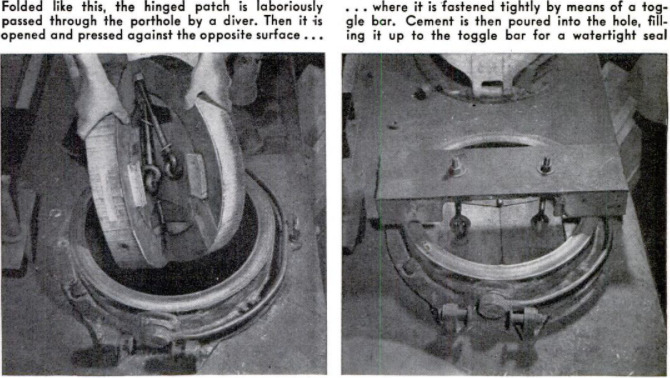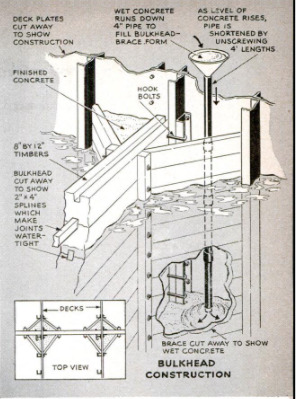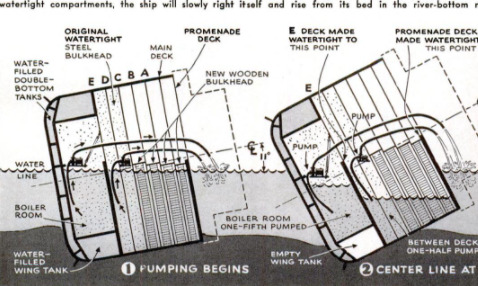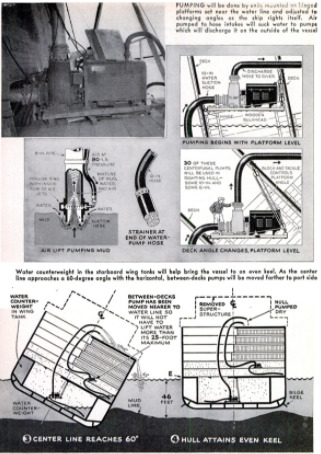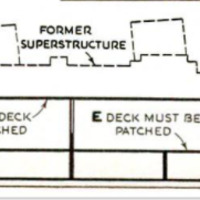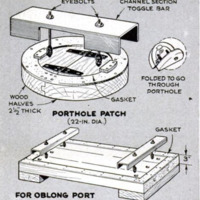-
Titolo
-
Saving a ship
-
Article Title and/or Image Caption
-
Title: Saving a ship for Uncle Sam
-
Subtitle: Salvage engineers are using all their tricks to give us back the Mammoth Normandie
-
extracted text
-
CONFRONTED by the biggest ship-salvage
job in marine history, the experts as-
signed to raise the former French liner Nor-
mandie from the mud of New York's North
River had to start literally at the bottom by
setting up their own school for divers. Under
war conditions, the 100 or more underwater
workers needed for the job simply could not be
found. Right at the pier where the mammoth
luxury ship (now the U.S.S. Lafayette) lay
on her side, Navy enlisted artificers were in-
structed in the rudiments of diving and under-
water salvage. At the same time, young naval
officers graduating in engineering were rushed
through a special course in naval architecture
to sorve as junior foremen on the big job.
To complicate the task, the only complete
set of blueprints of the mammoth ship had
been aboard when she burned and sank.
Those that could be recovered were drawn
up in the metric scale used by French de-
signers. For weeks the engineers had to
mark time while more than 500 workmen
explored the 1,029-foot vessel inch by inch,
the divers working by touch since the silt in
the water was so thick that even powerful
underwater lamps could not pierce it.
It soon became clear that salvaging prob-
lems never before raised had to be solved.
For one thing, the after portion of the
ship was bedded in soft mud whose maxi-
mum bearing capacity in some places was
less than the pressure exerted by the heeled-
over vessel. In addition, the layer of bed-
rock at the bottom of the slip rises toward
the shoreline at a uniform grade until it
reaches a level of 46 feet below low water at
a point about 250 feet aft of the bow, then
continues to the bulkhead line at the head
of the slip with a uniform level of minus
46 feet. The top of the mud line in the slip
occurs at about minus 36 feet, but samples
taken from this level down to minus 43 feet
showed the mud to be of very liquid con-
sistency. Although the greater portion of
the ship's weight was resting in mud, there
was found to be a considerable concentra-
tion of load at the edge of the rock shelf.
Engineers soon discovered that the ship's
original position was unstable. Transit rec-
ords taken at regular intervals indicated
that the stern was constantly settling
deeper in the mud, while the bow showed a
corresponding rise. The fulcrum of the mo-
tion was at the edge of the rock shelf.
There are at least 20 different ways of
salvaging a ship. The engineers working on
the Lafayette had to choose between them,
bearing in mind the special conditions pre-
vailing at Pier 88. Obviously, they could do
nothing that would disturb the mud in the
slip, since the ship's position was already so
precarious. The immediate job was to
lighten the stern or restore some lost buoy-
ancy quickly to the middle portion, as well
as to re-establish enough buoyancy to elimi-
nate the concentrated loading at the edge
of the rock shelf. After weighing the pros
and cons, the engineers finally cast their
votes for the method of controlled pump-
ing, whereby watertight compartments are
erected within the ship and then carefully
emptied in predetermined sequence so that
the list and trim of the vessel as it is floated
and righted will be subject to control.
This method, while quicker and more cer-
tain of success than any other, involves a
vast number of preliminary operations,
most of them under water. The vessel's list
and trim as it comes afloat will not be con-
trollable unless the movement of the free
water remaining in the ship is restricted by
both fore-and-aft and transverse bulkheads.
Before pumping can begin, all the compart-
ments which are to be emptied must be
sealed tight and drain holes must be in-
stalled to eliminate fatal water pockets.
However, before any constructive div-
ing operations inside the ship could get
under way, underwater compartments
had to be cleared of the mud and debris
with which they were clogged. When
the vessel toppled over, about 10,000
cubic yards of mud entered the hull
through open or broken air ports, cargo
ports, and deck hatches. To further com-
plicate matters, all the loose furniture,
ornamental fittings, and other equipment
had dropped to port and mixed with the
mud in the ship's lower portion. All this,
plus huge quantities of broken glass—
the diver’s deadly enemy, since it can cut
his air hose or rip his diving dress—had
to be cleaned out.
Today a great deal of this preliminary
work has been accomplished. Many par-
tition bulkheads, ornamental sheathings,
and deck insulations have already been
cut away wherever they interfere with
diving operations. And over 95 percent
of the ship's superstructure—practically
every item above the promenade deck,
including the three great smokestacks—
has been stripped away and scrapped,
yielding almost 4,000 tons of precious
metal. The removal of these top decks
has lowered the ship's center of gravity
and decreased the magnitude of move-
ment needed to right it.
Now most of the divers are hard at
work on the main job, that of sealing up
the compartments to be used in con-
trolled pumping. The underwater por-
tion of the promenade deck is being
reinforced from the main deck by shores,
to enable it to withstand external water
pressure when the pumping begins. All
of its submerged openings—elevator
hatches, air ducts, engine and boiler
hatches, as well as countless smaller
vents of all sizes and shapes—are being
sealed tight from the port side to a point
well above the high-tide level, so that
the deck will be serviceable as one of
the fore-and-aft bulkheads.
The other deck being used as a fore-
and-aft bulkhead is E deck, which in the
original design was more nearly watertight
than the others, since it was at the water
line and sealed in sections as a precaution-
ary measure. With the complete sealing of
the port sections of the promenade and B
decks, the ship will be divided longitudi-
nally into two compartments running from
bow to stern. These long chambers will, in
turn, be broken up by a series of transverse
bulkheads.
Practically all the Lafayette’ original
transverse bulkheads, except for a few near
the ends of the ship, were built up as far
as E or D deck, that is, just up to, or one
deck above, the water line when the ship
was afloat. But now, since the ship is over
on its port side at a 79-degree slant, the
original transverse bulkheads have to be
extended right straight through to the
promenade deck, then reinforced and built
up above the present low-water level, which
on the port side is almost halfway up the
110-foot-wide promenade deck. When this
huge job is finished there will be eight
transverse bulkheads extending clear out
to the promenade deck, spanning the entire
nine-deck depth of the ship, and four more
going up as far as E deck.
Building these bulkheads is the biggest
construction item, but another engineering
headache comes from the thousand-odd
vents found In all locations on the ship.
In addition to the approximately 375 air
ports, 14 cargo ports, and miscellaneous
scupper and drain pipe openings and
hatches now under water on the port side,
there are about 500 various openings in the
port side of the promenade deck alone
which must be blanked off.
When all the preliminary stripping and
bulkhead construction is finished, pumps will
be installed and the raising of the vessel will
begin. With a system of suction and dis-
charge pumping, controlled quantities of
water will be removed from the numerous
watertight chambers, starting down near
the bow to increase the buoyancy at that
point. until the ship floats clear from the
rock ledge on which it now rests. At the
same time, or immediately following, the
buoyancy aft and amidships will have to be
increased to prevent the rest of the ship
from nosing deeper into the mud.
Once the ship is completely afloat, the
pumping will be altered to cause a listing
‘movement that will bring it upright again.
During all these complicated pumping oper-
ations, the wing and double-bottom tanks
which line the ship's keel will be used as
supplementary controls, as well as all the
chambers built up by bulkheading and
sealing off the decks.
When the prostrate Lafayette is floated
and righted again, only half the battle, al-
though the toughest half by far, will have
been won. It will take many more months
before she is reconditioned and fitted out
for whatever war duties are assigned to her.
But in the meantime, invaluable experience
in salvage is being gained by the hard-
working experts who swarm over the ves-
sel's barren, rusted hull and feel their
way through its muddy depths. This experi-
ence will augment the number of trained
salvage personnel in the service—a valu-
able addition to our fighting services.
-
Autore secondario
-
Bernard Wolfe (Article Writer)
-
Lingua
-
eng
-
Data di rilascio
-
1943-02
-
pagine
-
108-113
-
Diritti
-
Public Domain (Google Digitized)
-
Archived by
-
Matteo Ridolfi
-
Marco Bortolami (editor)

